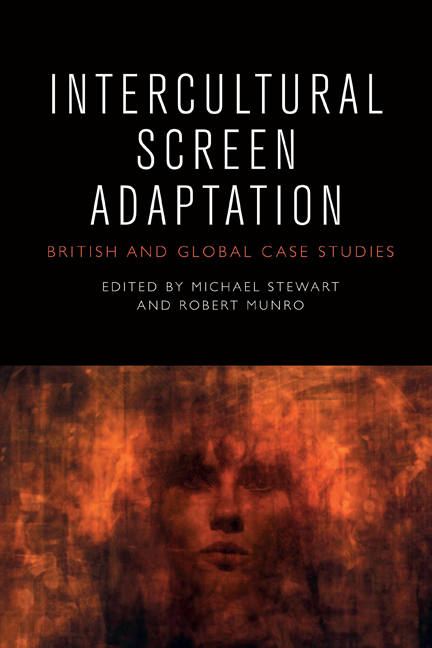Book contents
- Frontmatter
- Contents
- List of Illustrations
- Acknowledgements
- List of Contributors
- Introduction
- PART I NOSTALGIA, HERITAGE AND THE TOURIST GAZE
- 1 Adapting Pagnol and Provence
- 2 ‘A Tourist in Your Own Youth’: Spatialised Nostalgia in T2: Trainspotting
- 3 ‘200 Miles Outside London’: The Tourist Gaze of Far from the Madding Crowd
- PART II RADICAL CONTINGENCIES: NEGLECTED FIGURES AND TEXTS
- 4 Reframing Performance: The British New Wave on Stage and Screen
- 5 Why We Do Not Adapt Jean Rhys
- PART III RE-ENVISIONING THE NATIONAL IMAGINARY
- 6 ‘To see oursels as ithers see us’: Textual, Individual and National Other-selves in Under the Skin
- 7 Back to the Future: Recalcitrance and Fidelity in Julieta
- PART IV THE LOCAL, THE GLOBAL AND THE COSMOPOLITAN
- 8 El Patrón Del Mal: A National Adaptation and Narcos Precedent
- 9 Constructing Nationhood in a Transnational Context: BBC’s 2016 War and Peace
- 10 The Beautiful Lie: Radical Recalibration and Nationhood
- PART V REMAKING, TRANSLATING: DIALOGUES ACROSS BORDERS
- 11 In Another Time and Place: Translating Gothic Romance in The Handmaiden
- 12 Chains of Adaptation: From D’entre les morts to Vertigo, La Jetée and Twelve Monkeys
- 13 A ‘Double Take’ on the Nation(al) in the Dutch-Flemish Monolingual Film Remake
- Index
12 - Chains of Adaptation: From D’entre les morts to Vertigo, La Jetée and Twelve Monkeys
Published online by Cambridge University Press: 22 September 2020
- Frontmatter
- Contents
- List of Illustrations
- Acknowledgements
- List of Contributors
- Introduction
- PART I NOSTALGIA, HERITAGE AND THE TOURIST GAZE
- 1 Adapting Pagnol and Provence
- 2 ‘A Tourist in Your Own Youth’: Spatialised Nostalgia in T2: Trainspotting
- 3 ‘200 Miles Outside London’: The Tourist Gaze of Far from the Madding Crowd
- PART II RADICAL CONTINGENCIES: NEGLECTED FIGURES AND TEXTS
- 4 Reframing Performance: The British New Wave on Stage and Screen
- 5 Why We Do Not Adapt Jean Rhys
- PART III RE-ENVISIONING THE NATIONAL IMAGINARY
- 6 ‘To see oursels as ithers see us’: Textual, Individual and National Other-selves in Under the Skin
- 7 Back to the Future: Recalcitrance and Fidelity in Julieta
- PART IV THE LOCAL, THE GLOBAL AND THE COSMOPOLITAN
- 8 El Patrón Del Mal: A National Adaptation and Narcos Precedent
- 9 Constructing Nationhood in a Transnational Context: BBC’s 2016 War and Peace
- 10 The Beautiful Lie: Radical Recalibration and Nationhood
- PART V REMAKING, TRANSLATING: DIALOGUES ACROSS BORDERS
- 11 In Another Time and Place: Translating Gothic Romance in The Handmaiden
- 12 Chains of Adaptation: From D’entre les morts to Vertigo, La Jetée and Twelve Monkeys
- 13 A ‘Double Take’ on the Nation(al) in the Dutch-Flemish Monolingual Film Remake
- Index
Summary
The aim of this chapter is to explore what happens when the study of adaptations goes beyond the common binary pairing of a text and its filmic or televisual adaptation. The combination of literary/written text and filmed version, common in adaptation studies since George Bluestone's Novels into Film (2003, first published 1957), is decentred in Linda Hutcheon's A Theory of Adaptation (2006), which demonstrates how adaptation works across a range of media and in different directions, such as the novelisation of films or the adaptation of video games into films and films into video games. However, the notion of adaptation consisting of a pair of texts, one source and one target, remains common in the practice of writing about adaptations. The case study method in adaptation studies somewhat encourages this practice, as it structures analyses around close readings of the adaptation in relation to its source. Indeed, Hutcheon (2006: 120) argues that to experience a text as an adaptation (rather than as any other form of text), we must know the source text and be able to compare the two texts. Her point is echoed by Daniel Herbert (2017: 124), who notes that some forms of adaptation, such as the remake, encourage viewers to compare the adaptation with its source.
The connections between texts are seldom so simple. There are various layers of mediation between them: paratextual features (Genette 1987, Gray 2010) such as posters, covers, blurbs, tag-lines and even merchandise, can and do affect how texts are read and experienced and complicate the notion of smooth adaptation from one text to another. Translation, too, is often required for adaptation across languages: either there needs to be a translation of the source text, for example the novel being adapted will be translated into the language of the adapters, or there may be other processes of interlingual translation used in the process of adapting a text across languages. These paratexts and translational practices are often overlooked in analyses of cross-cultural adaptations, despite the effect they have on the perception of a text. Some of this may be related to the way in which translation tends to be made invisible in the West (Venuti 1995), or it may be due to the fact that paratexts and translations have lower cultural capital than novels and films.
- Type
- Chapter
- Information
- Intercultural Screen AdaptationBritish and Global Case Studies, pp. 206 - 221Publisher: Edinburgh University PressPrint publication year: 2020



